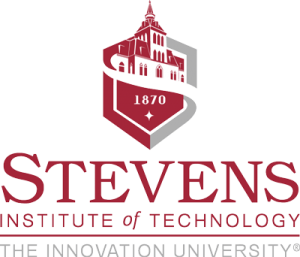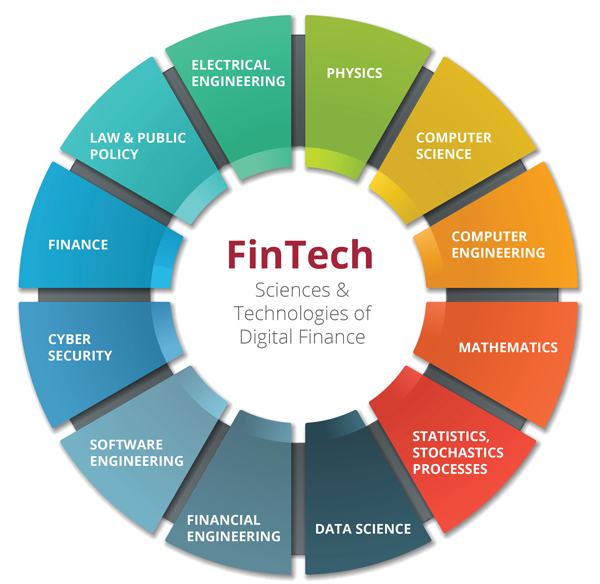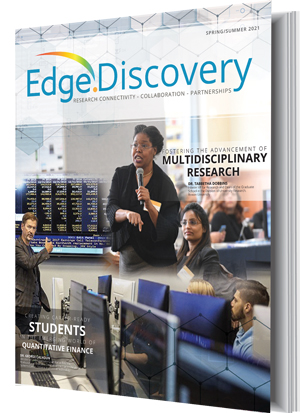 Approaching education with a cross-disciplinary approach, the School of Business at Stevens Institute of Technology offers a curriculum that integrates business and leadership development with technology and data. In today’s fast-paced world, every business is a tech business and acquiring a diverse set of skills, including technology, can help students seize more career opportunities. “After decades spent in technology and financial industries, I was looking for the next step in my career,” shares Dr. George Calhoun, Director of Undergraduate Quantitative Finance, Professor, and Executive Director of the Hanlon Financial Systems Center, Stevens Institute of Technology. “In 2003, I responded to an ad in The Economist about a new business school being formed at Stevens. They were looking for a candidate who had both a business and technology background to help further expand their business programs.”
Approaching education with a cross-disciplinary approach, the School of Business at Stevens Institute of Technology offers a curriculum that integrates business and leadership development with technology and data. In today’s fast-paced world, every business is a tech business and acquiring a diverse set of skills, including technology, can help students seize more career opportunities. “After decades spent in technology and financial industries, I was looking for the next step in my career,” shares Dr. George Calhoun, Director of Undergraduate Quantitative Finance, Professor, and Executive Director of the Hanlon Financial Systems Center, Stevens Institute of Technology. “In 2003, I responded to an ad in The Economist about a new business school being formed at Stevens. They were looking for a candidate who had both a business and technology background to help further expand their business programs.”
Prior to joining Stevens, Calhoun spent thirty years in the high-tech segment of the wireless communications industry, involved in the early development and commercialization of digital wireless architectures. “The radio channel was not fully engineerable in the conventional sense and the challenge over the years has been to figure out how to design a robust and high capacity radio signal that can support what people want to do,” says Calhoun. “Reflecting back, I was involved with two companies that were both in the middle of high technology development and advancement—early on in the wireless communications sector; later in the financial services sector.” Flash forward in the last ten to fifteen years with the financial industry and Calhoun notes, “Technology has jumed out in front of the management capabilities of the financial industry, and they are trying to catch up. Now, coming into academia as a businessman was helpful, because I had a deeper understanding of the industry and how to think in terms of product development and customers.”
Creating Tech-Savvy Graduates
Bringing his extensive experience and unique perspective to Stevens, Calhoun began by determining how to help expand the reach and recognition of the business school. “While Stevens is only fifteen minutes from Manhattan via train, there was little interaction with the financial world of New York and New Jersey at the time,” explains Calhoun. “Around the turn of the century, the financial industry started looking at Stevens as a source for recruiting students who had hard technology skills, including knowledge in quantitative methods and computer science. I spoke with over twenty-five companies in the financial services sector and beyond, like Johnson & Johnson and Honeywell, to determine what they were looking for from a graduate who is entering the financial services industry. The answers were consistent—they are seeking tech-savvy students who understand computer science, as well as financial domains, including finance, accounting, economics, capital markets, investment banking, and securitization.”
After these discussions, Calhoun concluded that there was an important business opportunity to develop a more focused program curriculum that would meet the targeted skills of the financial industry. “We used this insight to create an undergraduate program in 2009 called the Bachelors of Science in Quantitative Finance, offering both majors and minors in Quantitative Finance,” shares Calhoun. “This program has been very successful, with the highest incoming SAT scores and the highest starting salaries after graduation. The curriculum is very challenging. Incoming freshman are trained on the Bloomberg Terminal in the first semester and go on to complete seven computer science courses, seven math courses, and extensive financial domain courses.”
Stevens is one of the few universities to offer Quantitative Finance programs at the undergraduate level. The program has grown to 340 students and to include several different Masters’ programs. When combined, the undergraduate and Masters’ programs together constitute approximately 15 percent of the University’s population. “Even as undergraduates, many students will have two or three paid summer internships in the industry during their four years,” shares Calhoun. “Out of all of Stevens’ Quantitative Finance programs, 100-percent of graduates either gain employment or go on to graduate school with knowledge of risk management, investment banking, and financial modeling.” The variety of job opportunities is impressive, from software engineer and finance analyst to global technology or IT risk program manager. Many students are recruited by firms on Wall Street, but also begin careers in other fields like asset management or with insurance companies.
“Out of all of Stevens’ Quantitative Finance programs, 100-percent of graduates either gain employment or go on to graduate school with knowledge of risk management, investment banking, and financial modeling.”
– Dr. George Calhoun

A FEW EXAMPLES OF JP MORGAN JOB FUNCTIONS NJIT STUDENTS PLACED INTO INCLUDE THE FOLLOWING:
CIB Securities Analyst
Analyst – Global Finance & Business Management
Software Engineer
Finance Transformation Associate
Workplace Technology Innovation Associate
Vice President – Digital Finance & Business Management Associate
Lending Advisor Associate
Equity Derivative Sales
IT Risk Program Manager
Vice President – Technology & Disruptive Commerce
Vice President, Program Manager Global Security
Executive Director, Vice President – Global Technology
Digital Product Manager
Vice President – Corporate Client Banking
Mergers & Acquistions
Vice President | Corporate Derivatives Marketing
Public Finance Banking Regulatory Risk and Compliance
Technology Project Manager
Executive Director, Portfolio Manager, Multi-Asset Strategies
Executive Director, Divisional COO, Global Technology Infrastructure
CRAFT will carry out FinTech research that will apply advanced techniques and technologies from many of these fields to emerging applications in the financial services industry.
Some of the relevant technologies include:
- Machine Learning (ML) and Artificial Intelligence (AI) – to discover and exploit subtle patterns in large data-sets
- Natural Language Processing (NLP) – to extract useful signals from datasets derived from written or spoken human language
- Quantum Computing & Communication – using quantum techniques to improve computation speed and security
- Blockchain & Distributed Ledger technologies – designing self-regulating networks and processes for managing various types of data assets
- Advanced Optimization techniques – to apply powerful mathematical models to complex decisions
Applications to the financial services industry could include:
- Improved Credit risk analysis using ML/AI
- NLP applied to extract investment signals from financial text data, or to detect potential fraud or errors in financial statements
- Portfolio Construction and Immunization using advanced optimization
- AI-based tools for asset management and wealth management
- Risk engineering applied to control model risk, process risk, and other forms of business and financial risk
- Modeling & simulation of high frequency behavior of financial markets
- Blockchain applications to improve financial processes such as clearing, settlement, and “smart contracts”
- Quantum tech applied to generate high-quality randomness sources to support financial modeling and risk assessment (Monte Carlo), and enhanced cybersecurity techniques
1Realizing the digital promise. COVID-19 catalyzes and accelerates transformation in financial services. Deloitte. 2020.
Providing Real-World Experience
At the heart of the Hanlon Financial Systems Center in Stevens, is Hanlon Financial Systems Lab, a state-of-the-art laboratory that integrates the latest hardware and software technologies and provides research support, including data, training, and infrastructure. “From a generous gift by Stevens Trustee and Alumnus, Sean Hanlon, we created the Hanlon Financial Systems Lab, one of the first facilities of its kind in the United States, to facilitate research on pertinent topics in the financial sector,” says Calhoun, who is Executive Director of the Center. “Just like chemists need a chemical lab and biologists need a biology lab, we wanted to give students a place to gain experience with the tools of the trade.”
Calhoun says the innovative facility looks similar to a small trading floor on Wall Street with Bloomberg terminals. The setup of the Lab supports the teaching requirements in the curriculum and gives students exposure to tools, software, and data sets that they will use in the workforce. “With approximately seventy seats, the Center has become a key part of the educational component of the School of Business,” says Calhoun. “We support around eighty different undergraduate and graduate classes in the course of a week, with over a thousand students utilizing the facility in the course of a semester.”
Merging Finance and Technology
Over forty years ago, the National Science Foundation (NSF) created the Industry/University Cooperative Research Center (I/UCRC) model to focus research attention and build institutional support related to critical fields of science and technology. The three core objectives of the model include conducting high-quality, high-impact research; enhancing U.S. global leadership in financial technologies, or FinTech; and developing a diverse, high-tech, skilled workforce.
With these initiatives in mind, Stevens and Rensselaer Polytechnic Institute are hoping to create a new national research center, co-sponsored by the NSF, with the goal of advancing innovative FinTech. The first ever industry-university cooperative research center (IUCRC) to focus on financial technology, the Center for Research toward Advancing Financial Technologies (CRAFT) will join academic and industry participants with government representatives to find innovative solutions for complex challenges facing the FinTech industry.
CRAFT is actively recruiting members from academia, government, and industry and aims to close the gap between the world of traditional finance and the emerging fields of advanced technology. “We held a two-day virtual workshop this past October with representatives from over sixty financial firms, as well as regulators from the Securities and Exchange Commission (SEC), Federal Reserve, and Treasury Department,” shares Calhoun. “The updated proposal was submitted to the NSF for review in January 2021. If approved, we hope to join forces with many different organizations and institutions to create powerful momentum in the field of FinTech research.”
To share his years of experience and insight and help further advance financial technology education, Calhoun added author to his resume early last year with the publishing of his book, Price and Value: A Guide to Equity Market Valuation Metrics (Quantitative Finance). His book seeks to assist not only students in finance-related programs, but all levels of financial professionals who are searching for the tools needed to assess business strategy and performance and wish to gain a more profound understanding of quantitative finance. Additionally, Calhoun is regularly featured as an Online columnist for Forbes magazine as a contributor in the Markets section of the publication.
 Exploring the Rise of FinTech
Exploring the Rise of FinTech
The rise of FinTech has largely been driven by consumers who expect financial institutions to provide the same online experiences that they are accustomed to in their personal and social media interactions. This form of digital finance has entered the mainstream globally, and has only increased over the past year following the onset of COVID. Recent studies have revealed that 35-percent of customers have increased their online banking usage during the pandemic, with seniors and boomers making up a significant share of these individuals.1 “All of the functions we do in the digital world, from paying credit cards, mortgages, car payments to transacting with our bank, all of this can be done electronically in a quick and secure way,” says Calhoun. “From the industry’s standpoint, they can collect more accurate data on their customers and gather analytics on all the different ways in which that individual interacts with the financial market.”
The financial component of FinTech includes the design and operation of financial market infrastructure systems, the creation and testing of innovative financial instruments and strategies, and the integration of cloud-based financial services. Drawing upon technology that has already been developed in science, mathematics, and computer engineering, the FinTech industry looks to incorporate machine learning and artificial intelligence, quantum computing and communications, and advanced optimization modeling techniques. With advancements in the modern high-tech financial industry, the need arose for a center dedicated to exploring the challenges associated with rapid industry growth. Henceforth, CRAFT and the IUCRC for FinTech Research, was formed. CRAFT’s mission is to assist the industry in achieving coherence in FinTech research and policy to help bridge the gap between the world of traditional finance and the emerging fields of advanced technology.
Calhoun says the revolution that is underway in the financial industry will greatly benefit from having industry and university cooperation. “There are certain things that the university can bring to the table that the industry doesn’t necessarily have the time or the right people to invest in, and by the same token, the industry is where a lot of this evolution is happening. New Jersey is very committed to the financial services industry and acknowledges the importance of current FinTech trends. We must ensure that academic research is well engaged with the industry side, and this is the key focus of CRAFT.”
CRAFT also aims to serve as a common forum for organizations to collaborate on industry-wide topics and challenges and receive insight from financial regulators on public policy and regulation in the FinTech field. Research projects will largely be conducted by students at the participating Universities where they work alongside industry members at their corresponding facilities. This opportunity allows students to connect with potential employers and for organizations to preview future hires. The FinTech research at CRAFT will apply advanced techniques and technologies, including using Machine Learning (ML) and Artificial Intelligence (AI) to discover subtle patterns in large data sets, exploring how quantum techniques can improve computation speed and security, and investigating how AI-based tools can be used for asset and wealth management.



